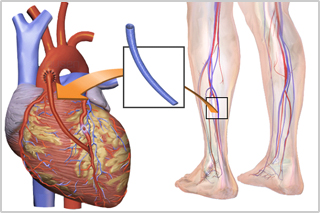It is most commonly performed on people whose coronary arteries (blood vessels supplying blood to heart) are blocked, thus reducing the flow of blood to the heart.
The human heart is a fascinating piece of biological machinery. It is made up of special types of muscles called "cardiac muscles." These are different from the other muscles in the body, which can get tired after a bout of physical activity. Ask your calf muscles about it after a 100 metres sprint! Cardiac muscles, on the other hand, never tire and are meant to work for the entire lifetime of the individual. They do not need rest.
However, what the cardiac muscles do need, to work tirelessly and constantly, is a continuous blood supply. This blood should be rich in oxygen, apart from its usual dose of nutrients. The blood vessels that supply this oxygen-rich blood to the heart muscles are called "coronary arteries." Now imagine what would happen if these coronary arteries were blocked. The blood supply to the heart will decrease and the person experiences chest pain called "angina." In severe cases of blockages, the person may suffer from a heart attack.
Angina is caused by deposition of a "plaque" on the inner walls of the coronary arteries. This plaque is composed of lipids, cholesterol and other fatty material. This may harden and even rupture to cause a blood clot, which can sometimes, almost or completely block the flow of blood inside a coronary artery. This causes, what is known as coronary heart disease (CHD) or coronary artery disease (CAD).

CABG surgery is a way to treat patients with CHD. In this procedure, a healthy blood vessel is "harvested" from another part of the body and is attached to the existing coronary artery in such a way so as to "bypass" the blocked part. A healthy blood vessel is generally removed from the inner thigh, the calf region, the chest or the wrist.
During the surgery, the breastbone (sternum) is cut in half to expose the heart. The heart is stopped for the surgeon to perform the extremely delicate surgery. In the meantime, the patient is kept alive through a heart-lung machine, which keeps the blood pumping throughout the body.
Apart from this "traditional" approach, newer techniques, which are less invasive, have been developed. One such procedure is the "off-pump" procedure, where the heart is not stopped and is kept pumping. "Key-hole" and "robotic" surgeries are modern approaches, yet the traditional "open heart" approach is still used and preferred in certain cases of CHD.
Many risks are associated with this procedure, as with other major surgeries. There may be a blood clot at the site of surgery, or an infection may develop; there could be breathing problems, or uncontrolled bleeding during and/or after the surgery.
A successful graft may last for 8 to 15 years; it is dependent on a number of factors. It is always advisable to embrace lifestyle changes like diet control, giving up smoking and alcohol consumption. Light exercising also helps in keeping the heart healthy.